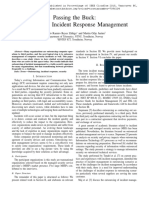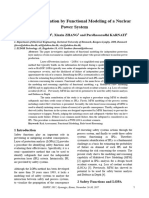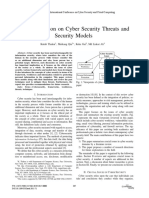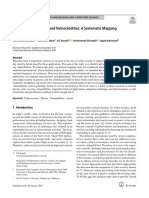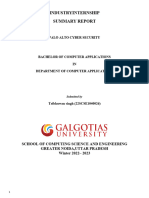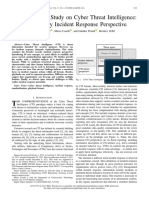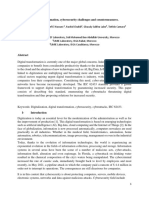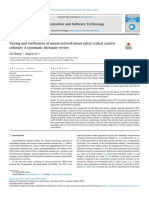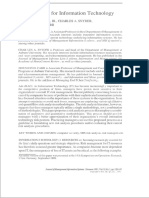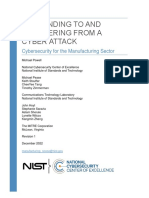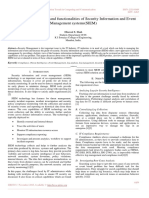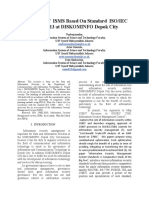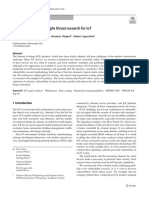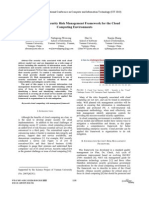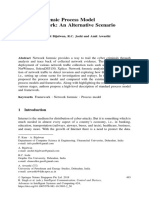Propositions For Effective Cyber Incident Handling
Propositions For Effective Cyber Incident Handling
Uploaded by
Senait MebrahtuCopyright:
Available Formats
Propositions For Effective Cyber Incident Handling
Propositions For Effective Cyber Incident Handling
Uploaded by
Senait MebrahtuOriginal Description:
Original Title
Copyright
Available Formats
Share this document
Did you find this document useful?
Is this content inappropriate?
Copyright:
Available Formats
Propositions For Effective Cyber Incident Handling
Propositions For Effective Cyber Incident Handling
Uploaded by
Senait MebrahtuCopyright:
Available Formats
See discussions, stats, and author profiles for this publication at: https://www.researchgate.
net/publication/332977234
Propositions for Effective Cyber Incident Handling
Conference Paper · October 2018
CITATIONS READS
0 141
4 authors, including:
Jung-Woon Lee Jong-Gyun Choi
Korea Atomic Energy Research Institute (KAERI) Korea Atomic Energy Research Institute (KAERI)
27 PUBLICATIONS 299 CITATIONS 16 PUBLICATIONS 101 CITATIONS
SEE PROFILE SEE PROFILE
Some of the authors of this publication are also working on these related projects:
biomechanics - human finger View project
cyber security R&D projects in Korean nuclear facilities View project
All content following this page was uploaded by Jung-Woon Lee on 10 May 2019.
The user has requested enhancement of the downloaded file.
Transactions of the Korean Nuclear Society Autumn Meeting
Yeosu, Korea, October 25-26, 2018
Propositions for Effective Cyber Incident Handling
Jung-Woon Lee*, Jae-Gu Song, Jun Young Son, and Jong-Gyun Choi
Nuclear ICT Research Division, Korea Atomic Energy Research Institute, Daejeon, Republic of Korea
*
Corresponding author: leejw@kaeri.re.kr
1. Introduction phases and tasks in the models are analyzed in
consideration of their application in Korean nuclear
Digital technologies have been applied expansively to facilities.
nuclear instrumentation and control (I&C) systems. This
application has raised cyber security issues. U. S. NRC 2.1 Models in IT Environments
published the regulatory guide 5.71 (RG 5.71) in 2010
[1]. Korea Institute of Nuclear Nonproliferation and The cyber incident analysis process guide by Korea
Control (KINAC) has prepared the regulatory standard Internet and Security Agency (KISA) [6] is a guidance
RS-015 [2] based on RG 5.71. Korean nuclear facilities for incident response in the domestic IT environments.
submitted their cyber security plan (CSP) and have It describes the seven steps of cyber incident response
implemented the elements of CSP. process including 1) preparation, 2) detection, 3) initial
According to regulatory documents [1] & [2], the response, 4) response strategy development, 5) incident
cyber security plan must include incident response and investigation, 6) reporting, 7) recovery & resolution, as
recovery measures by describing how to: illustrated in Fig. 1.
- maintain the capability for timely detection and
response to cyber attacks,
- mitigate the consequences of cyber attacks,
- correct exploited vulnerabilities, and
- restore affected systems, networks, and
equipment affected by cyber attacks.
Nuclear I&C systems have a form of industrial
control systems (ICS). ICS is a general term that
Fig. 1. Seven steps of cyber incident response [6]
encompasses several types of control systems, including
supervisory control and data acquisition (SCADA)
systems, distributed control systems (DCS), and other NIST SP 800-61 [7] depicts the incident response
control system configurations such as Programmable process consisted of phases: 1) preparation; 2) detection
Logic Controllers (PLC) often found in the industrial & analysis; 3) containment, eradication & recovery; 4)
sectors and critical infrastructures [3]. Typically, ICS post-incident activity. NIST SP 800-86 [8] provides a
consists of field devices, such as Remote Terminal Units guide to integrate forensic technologies with incident
(RTU), PLCs, and Intelligent Electronic Devices (IED), response. The forensic process in this report includes
control servers, engineering workstations, data historian, data collection, examination, analysis, and reporting.
human-machine interface (HMI), and network The cyber incident handling program by U.S.
communication devices [3]. These are the components Department of Defense [9] describes cyber incident
that also can be found in nuclear I&C systems. handling process grouped into the following phases: 1)
Stuxnet in 2010 was the first malware to specifically detection of events; 2) preliminary analysis and
target SCADA systems and PLCs [4]. There have been identification of incidents; 3) preliminary response
many other prominent cyber attacks against ICS [5]. actions; 4) incident analysis; 5) response and recovery;
From these incidents, it can be known that well- and 6) post-incident analysis. Fig. 2 shows these phases.
prepared cyber incident response capability is important
to detect and respond to cyber incidents in a timely
manner.
In this paper, models of cyber incident handling
process are surveyed. Based on this survey, a model of Fig. 2. Cyber incident handling process [9]
cyber incident handling process is proposed and
research and development (R&D) activities to establish 2.2 Models in ICS Environments
effective incident handling capabilities are suggested.
According to [10], planning, incident prevention,
2. Models of Cyber Incident Handling Process and post-incident analysis/forensics (top three ones in
Fig. 3) are the elements for cyber incident response
In this section models of cyber incident handling capability that are proactive in nature to prevent an
process in both Information Technology (IT) incident or better allow the organization to respond
environments and ICS environments are reviewed. The when one occurs. Detection, containment, remediation,
Transactions of the Korean Nuclear Society Autumn Meeting
Yeosu, Korea, October 25-26, 2018
and recovery and restoration (bottom four ones in Fig.
3) are the elements for detecting and managing an
incident once it occurs.
Fig. 3. Incident response key elements [10]
In [11], the core components of cyber incident
response with an embedded forensics component are: 1) Fig. 5. SCADA Incident Response and Forensic Process [16]
detection; 2) response Initiation; 3) incident response
action/forensic collection, 4) incident recovery/forensic
analysis, and 5) incident closure/forensic reporting.
In [12] and [13], the post-incident (forensic) analysis
process includes 1) examination, 2) identification of
evidence, 3) collection of evidence, 4) analysis of
evidence, and 5) documentation of the process and
results. In [12], the cyber incident response process
quite similar to that in [11] is also described. The ICS
incident response process with a forensic approach in
[14] consists of 1) preparation of control system
baselines, network monitoring, logging, tools, incident
response team, incident response plan, and training, 2)
volatile and non-volatile evidence preservation, 3)
evidence analysis, 4) restoration, and 5) lessons learned. Fig. 6. SCADA forensic incident response model [17]
Other incident forensic processes can be found in [15],
[16], and [17]. These are illustrated in Figs. 4, 5, and 6, 3. Proposed Model and R&D Suggestions
respectively.
An IAEA document for nuclear facilities [18] also In this section, a model for cyber incident handling is
describes the phases of computer incident response with proposed and R&D activities are suggested to establish
a list of tasks and its assignment to incident response effective incident handling capabilities.
team members. The phases are 1) preparation, 2)
detection and analysis, 3) mitigation (containment, 3.1 Proposed Model of Incident Handling Process
eradication, and recovery), 4) post-incident activity, and
5) reporting. Most of the tasks described in this A model of three stages, which are monitoring,
document, however, are not specific to ICS environment. incident response, and forensics as shown in Fig. 7, is
proposed in consideration of incident handling
capability aspects.
Fig. 7. Proposed incident handling model
Detecting an incident early will help to limit or even
Fig. 4. Incident response forensic process [15] prevent possible damage and reduce the downstream
efforts to contain, eradicate, recover, and restore the
affected systems [10]. Two general approaches can
detect an ICS cyber security incident. The first is
Transactions of the Korean Nuclear Society Autumn Meeting
Yeosu, Korea, October 25-26, 2018
through user observation of abnormal system or Develop a mitigation strategy
component behavior. The second is through automated Research and develop course of actions.
detection systems or sensors [6, 9, 10, 18]. Monitoring Eradicate the incident
capability is important for effective detection, allowing Identify and mitigate all vulnerabilities that were
to start the incident response process. It is difficult to exploited
determine whether or not abnormal symptoms are Remove malware, inappropriate materials, and other
associated with a malicious attack or usual component components
malfunction [19, 20]. In this sense, the proposed model Recover from Incident.
incorporates process monitoring as well as security 3) Post-Incident Analysis Phase
monitoring during the monitoring stage. Depending on Develop lessons learned.
incident characteristics, in some cases of incidents, Enhance security measures to prevent re-infection.
digital forensics technologies may need to be applied by
specialist trained forensic examiners during the incident Non-technical matters such as coordination, reporting,
response stage [15]. A link between the incident escalation, and documentation are not included in this
response stage and the forensics stage is placed in the list of actions. However, these should be considered in
model. the development of site-specific incident response
Based on the survey of the models in section 2, strategies and procedures.
actions to be performed in the three phases of incident
response stage are collected and described as follows: 3.2 Research and Development Suggestions
1) Detection & Diagnosis Phase
Identify suspicious behavior or cyber events of Based on the three stages of the model, R&D activities
interest are suggested. Present nuclear I&C systems have many
Prepare to handle the event different types of digital assets from many different
- collect all relevant information about the event, vendors. This means the results of development for a
such as design documents, network diagrams, plant or a type of asset cannot be effective or applicable
configuration baselines, change logs, and to other plants or other types of assets. Hence, the
authentication credentials development should be plant-specific and dependent on
- prepare incident analysis hardware and software the characteristics of assets.
Analyze precursors and indicators 1) Development of cyber event monitoring system
Look for correlating information For the enhancement of monitoring capability, a
Determine if the event is a reportable cyber event or cyber event monitoring system should be implemented.
incident Cyber event monitoring technology for IT environments
Determine potential infected areas is widely used, but applying this to ICS environments
Compare the characteristics of digital assets needs adjustments or new developments. Automated
involved in the event to known baselines detection systems, such as network intrusion detection
Check the integrity of digital assets involved in the systems, protocol-based intrusion detection systems,
event if possible host-based intrusion detection systems, and network and
Perform preliminary impact assessment and device logging and analysis systems, should be
determine potential damage developed and installed.
Categorize the event and Classify the security level 2) Development of incident response strategies and
Determine if immediate actions are required to place procedures
the facility in a safe and secure condition For the enhancement of incident response capability,
Perform immediate response actions procedures with if-then rule-based and step-by-step
- contain the incident description of actions are necessary, especially for the
- identify data sources based on the type of incident detection and diagnosis phase of the incident response
- safely acquire and preserve the integrity of all data stage.
to allow for further incident analysis Existing procedures addressing plant abnormal states,
2) Incident Analysis & Response Phase such as abnormal operation procedures and alarm
Assess the impact of volatile data capture against the procedures, need to incorporate decision points to
safety and operation of the system. identify that abnormal events are cyber-related so that
Collect and preserve information the diagnosis of events can be transferred to the incident
- collect volatile evidence response process.
- collect non-volatile evidence Criteria to determine whether detected suspicious
Perform incident analysis symptoms or anomalies are a cyber incident or not
- develop a timeline of the incident should be developed based on the implemented
- determine delivery vector(s) monitoring capabilities in a specific plant. The criteria
- determine system weaknesses should be included in procedures for the detection &
- identify root cause(s) diagnosis phase. Experiments on a test-bed to explore
- expand previous impact assessment system changes that may be incurred by an acceptable
Transactions of the Korean Nuclear Society Autumn Meeting
Yeosu, Korea, October 25-26, 2018
list of potential cyber attacks against ICS will help the [6] Cyber Incident Analysis Process Guide, Korea Internet
development of criteria. and Security Agency (KISA), 2010.
Hardware and software configuration baselines [7] Cichonski, P., Millar, T., Grance, T., & Scarfone, K., SP
800-61 Rev. 2. Computer Security Incident Handling Guide.
should be prepared. The baselines will be used to
Tech. rep., National Institute of Standards & Technology
identify any changes made in systems and assets during (NIST), Gaithersburg, MD, United States, 2012.
the detection and diagnosis phase. [8] Kent, K., Chevalier, S., Grance, T., & Dang, H., SP 800-
Device and system integrity checking methods and 86. Guide to integrating forensic techniques into incident
tools need to be developed also for detection and response. National Institute of Standards & Technology
diagnosis purposes. (NIST), Gaithersburg, MD, United States, 2006.
Mitigation strategies for critical digital assets should [9] U.S. Department of Defense, Chairman of the Joint Chiefs
be developed by considering the configurations of of Staff Manual, Cyber Incident Handling Program: CJCSM
systems under the circumstances incurred by an 6510.01B, 10 July 2012 (Directive Current as of December 18,
2014)
acceptable list of potential cyber attacks. The strategies
[10] Department of Homeland Security, Recommended
should be incorporated into mitigation procedures practice: Developing an Industrial Control Systems
3) Development of forensic and incident analysis Cybersecurity Incident Response Capability. Technical report,
technology Department of Homeland security, 2009.
ICS processes a large amount of data in real time. [11] Mark Fabro and Eric Cornelius, Recommended
Data collection and analysis technologies in ICS practice: Creating cyber forensics plans for control systems.
environments need to be developed, especially for field Department of Homeland Security, 2008.
devices and other assets having characteristics different [12] Pauna, A., Moulinos, K., Lakka, M., May, J., &
from those in IT environments. The methods and tools Tryfonas, T., Can we learn from SCADA security incidents.
White Paper, European Union Agency for Network and
should be fitted into the type of digital assets. Volatile
Information Security (ENISA), Heraklion, Crete, Greece,
data collection and live incident analysis should be 2013.
considered in the development. [13] Spyridopoulos, T., Tryfonas, T., & May, J. H. R.,
4) Development of Incident Response Training Incident Analysis & Digital Forensics in SCADA and
Training tools and contents should be developed Industrial Control Systems. In System Safety Conference
based on incident response procedures for relevant incorporating the Cyber Security Conference 2013, 8 th IET
personnel to practice the incident response process. International (pp. 1-6). Institution of Engineering and
Technology (IET), 2013. DOI: 10.1049/cp.2013.1720
3. Conclusions [14] Folkerth, Lew, Forensic Analysis of Industrial Control
Systems, SANS Institute InfoSec Reading Room, September
2015. Accessed on July 6. 2018.
Establishing and maintaining cyber incident response https://www.sans.org/reading-
capabilities is important in nuclear facilities. Based on room/whitepapers/forensics/forensic-analysis-industrial-
the survey of cyber incident handling processes, a model control-systems-36277
consisted of monitoring, incident response, and [15] Wu, T., Disso, J. F. P., Jones, K., & Campos, A.,
forensics stages is proposed. R&D activities to establish Towards a SCADA forensics architecture. In Proceedings of
effective monitoring, incident response, and forensics the 1st International Symposium for ICS & SCADA Cyber
capabilities in nuclear facilities are suggested. Security Research (Vol. 12), September 2013.
[16] Betts, M., Stirland, J., Olajide, F., Jones, K., & Janicke,
H., Developing a state of the art methodology & toolkit for
REFERENCES
ICS SCADA forensics. Int. J. Ind. Control Syst.
Secur.(IJICSS), 1(2), 44-56, 2016.
[1] Regulatory Guide 5.71, Cyber Security Programs for
[17] Eden, P., Blyth, A., Jones, K., Soulsby, H., Burnap, P.,
Nuclear Facilities, U.S. Nuclear Regulatory Commission,
Cherdantseva, Y., & Stoddart, K., SCADA System Forensic
2010.
Analysis Within IIoT. In Cybersecurity for Industry 4.0 (pp.
[2] KINAC/RS-015, Technical standard for the security of
73-101). Springer, Cham, 2017.
computer and information systems in nuclear facilities, Rev. 1,
[18] International Atomic Energy Agency, Computer
KINAC, 2014.
Security Incident Response Planning at Nuclear Facilities,
[3] Keith Stouffer, Victoria Pillitteri, Suzanne Lightman,
IAEA, Vienna, 2016.
Marshall Abrams, and Adam Hahn, SP 800-82, Rev. 2, Guide
[19] Johnson, C. W., Harkness, R., & Evangelopoulou, M.,
to Industrial Control System (ICS) Security, National Institute
Forensic Attacks Analysis and the Cyber Security of Safety-
of Standards and Technology (NIST), Gaithersburg, MD,
Critical Industrial Control Systems, In Proceeding of the 34th
United States, May 2015
International System Safety Conference, Orlando, USA 8-12
[4] Barak Perelman, The Rise of ICS Malware: How
August 2016, International System Safety Society, Unionville,
Industrial Security Threats Are Becoming More Surgical,
Virginia, USA, 2016.
February 21, 2018. Accessed on July 30, 2018.
[20] Takano, M., ICS cybersecurity incident response and
https://www.securityweek.com/rise-ics-malware-how-
the troubleshooting process. In 2014 Proceeding of the SICE
industrial-security-threats-are-becoming-more-surgical
Annual Conference (SICE), Sapporo, 2014, pp. 827-832.
[5] Derbyshire, R., Green, B., Prince, D., Mauthe, A., &
Hutchison, D. An Analysis of Cyber Security Attack
Taxonomies. In 2018 IEEE European Symposium on Security
and Privacy Workshops (EuroS&PW). IEEE, April, 2018.
View publication stats
You might also like
- Microprocessors and MicrosystemsDocument33 pagesMicroprocessors and MicrosystemsAsish KumarNo ratings yet
- Cyber Resilience Framework For Industrial Control SystemsDocument7 pagesCyber Resilience Framework For Industrial Control SystemsionicaNo ratings yet
- Spyder 4 Pro Serial 11 PDFDocument4 pagesSpyder 4 Pro Serial 11 PDFRubenNo ratings yet
- 1 s2.0 S1738573321002990 MainDocument10 pages1 s2.0 S1738573321002990 MainWilbert ACNo ratings yet
- Cyber Security Controls in Nuclear Power Plant byDocument14 pagesCyber Security Controls in Nuclear Power Plant byshivarajulmnNo ratings yet
- Risk Assessment Methodology Based On The NISTIR 7628 GuidelineDocument10 pagesRisk Assessment Methodology Based On The NISTIR 7628 Guidelinehaitam lfridiNo ratings yet
- Outsource AuthorversionDocument6 pagesOutsource AuthorversionCom DigfulNo ratings yet
- Research PaperDocument45 pagesResearch PaperAnand kumarNo ratings yet
- UNavailability Assessment of Redundant SISDocument43 pagesUNavailability Assessment of Redundant SISGirish KasturiNo ratings yet
- Minor Project Report ON: "General It Control - RCM"Document33 pagesMinor Project Report ON: "General It Control - RCM"yashutank46No ratings yet
- Cloud Incident Response Model: October 2016Document4 pagesCloud Incident Response Model: October 2016Senait MebrahtuNo ratings yet
- The Concept of Cyber Defence Exercises (CDX) : Planning, Execution, EvaluationDocument9 pagesThe Concept of Cyber Defence Exercises (CDX) : Planning, Execution, EvaluationLakshani AkalankaNo ratings yet
- 180 655 1 PBDocument8 pages180 655 1 PBMuhammad BangkoNo ratings yet
- C4ISR Cyber Security FinalDocument37 pagesC4ISR Cyber Security FinalSerkan KalaycıNo ratings yet
- Roles - CERT inDocument1 pageRoles - CERT inapi-27477209No ratings yet
- Eco-Friendly Low Resource Security Surveillance Framework Toward Green AI Digital TwinDocument4 pagesEco-Friendly Low Resource Security Surveillance Framework Toward Green AI Digital TwinLibrarian SCENo ratings yet
- ISOFIC 2017 Jing WUDocument10 pagesISOFIC 2017 Jing WUJinyoung ChoiNo ratings yet
- CSCloud 2015 71-63Document5 pagesCSCloud 2015 71-63AnanyaNo ratings yet
- 10.1007@s13369 019 04319 2Document19 pages10.1007@s13369 019 04319 2matuNo ratings yet
- Security Operations & Incident Management Knowledge Area: Herv e DebarDocument55 pagesSecurity Operations & Incident Management Knowledge Area: Herv e DebarPaco EgNo ratings yet
- Shoib Ka BetaDocument23 pagesShoib Ka Betaxenaj90745No ratings yet
- Electric Power Systems Research: Cyber Security Assessment of A Power PlantDocument9 pagesElectric Power Systems Research: Cyber Security Assessment of A Power PlantRajib BanerjeeNo ratings yet
- A Comparative Study On Cyber Threat Intelligence The Security Incident Response PerspectiveDocument32 pagesA Comparative Study On Cyber Threat Intelligence The Security Incident Response PerspectiveRupesh VardhanNo ratings yet
- 2-CIASG 2017 BCF Framework Paper V7Document7 pages2-CIASG 2017 BCF Framework Paper V7sawda.shoshi29No ratings yet
- 2012 - A Cyber-Physical Experimentation Environment For The Security Analysis of Networked Industrial Control SystemsDocument16 pages2012 - A Cyber-Physical Experimentation Environment For The Security Analysis of Networked Industrial Control SystemsTomNo ratings yet
- CyberPhysical System Security For The Electric Power GridDocument15 pagesCyberPhysical System Security For The Electric Power Gridtalha42103No ratings yet
- Lab #10: Create A Cirt Response Plan For A Typical It InfrastructureDocument3 pagesLab #10: Create A Cirt Response Plan For A Typical It InfrastructureHờ Bờ LờNo ratings yet
- Disaster Management Using Internet of Things: August 2017Document6 pagesDisaster Management Using Internet of Things: August 2017mujahed1987No ratings yet
- Cyber SecurityDocument107 pagesCyber SecuritySiddharth YadavNo ratings yet
- Applsci 13 03843 v2Document27 pagesApplsci 13 03843 v2ugrceylnNo ratings yet
- Articulo 7Document10 pagesArticulo 7Marcos CarbajalNo ratings yet
- Cyber Security and Resilience Guidelines 1705329624Document24 pagesCyber Security and Resilience Guidelines 1705329624adarshmv MvNo ratings yet
- Digital Transformation Cybersecurity ChaDocument11 pagesDigital Transformation Cybersecurity ChaKhoi DangNo ratings yet
- Ristola Teemu (RICK MMM)Document35 pagesRistola Teemu (RICK MMM)Fintech SpaceNo ratings yet
- Testing and Verification of Neural Network Based Safet 2020 Information andDocument21 pagesTesting and Verification of Neural Network Based Safet 2020 Information andDionísio XimenesNo ratings yet
- Cyber-Physical Systems Security Issue 1.0Document53 pagesCyber-Physical Systems Security Issue 1.0metokcedricjNo ratings yet
- 7622 20429 1 PBDocument12 pages7622 20429 1 PBSyed AhamedNo ratings yet
- 1 s2.0 S0951832021003410 MainDocument12 pages1 s2.0 S0951832021003410 MainmkNo ratings yet
- Comparison of Some Selected Methods For Accident Investigation PDFDocument9 pagesComparison of Some Selected Methods For Accident Investigation PDFSyifa AndalusiaNo ratings yet
- Fan Fan en Ist 143 09Document18 pagesFan Fan en Ist 143 09su yuNo ratings yet
- Analysis Information: TechnologyDocument20 pagesAnalysis Information: TechnologyFaeza AzwinNo ratings yet
- Cybersecurity Vulnerability Mitigation Framework Through EmpiricalDocument27 pagesCybersecurity Vulnerability Mitigation Framework Through EmpiricalBelther LeccaNo ratings yet
- How To Write AssignmentDocument6 pagesHow To Write Assignmentqueen heartNo ratings yet
- Computer Forensics Guidance Model With Cases StudyDocument8 pagesComputer Forensics Guidance Model With Cases StudyGeorge AzevedoNo ratings yet
- Responding To and Recovering From A Cyber AttackDocument22 pagesResponding To and Recovering From A Cyber Attacknitsuga71No ratings yet
- A Study On Capabilities and Functionalities of Security Information and Event Management Systems (SIEM)Document5 pagesA Study On Capabilities and Functionalities of Security Information and Event Management Systems (SIEM)Editor IJRITCCNo ratings yet
- Arduino Based Motion Trigger CameraDocument29 pagesArduino Based Motion Trigger CameraAbdul Hafiz75% (4)
- Francia Et Al - Security Best Practices and Risk Assessment of SCADA and ICSDocument7 pagesFrancia Et Al - Security Best Practices and Risk Assessment of SCADA and ICSarshamin786No ratings yet
- Contoh-Artikel-FKI 7 0Document6 pagesContoh-Artikel-FKI 7 0Minari BoysNo ratings yet
- SPE - DescriptionDocument5 pagesSPE - DescriptionJuan VelasquezNo ratings yet
- Implementation of Security Information Event ManagDocument7 pagesImplementation of Security Information Event Managrokoman kungNo ratings yet
- Reducing Cyber Risks For Industrial Control SystemsDocument60 pagesReducing Cyber Risks For Industrial Control SystemsKarthikeyan VarathanNo ratings yet
- PS 20 - Suren 2023Document21 pagesPS 20 - Suren 2023einstein.ortiz27No ratings yet
- A Security-Aware Framework For Designing Industrial Engineering ProcessesDocument21 pagesA Security-Aware Framework For Designing Industrial Engineering ProcessesFrank Joel Herrera ApaesteguiNo ratings yet
- Scientific Paper NMPereira FinalDocument9 pagesScientific Paper NMPereira FinalSenait MebrahtuNo ratings yet
- Information Security Risk Management Framework For The CloudDocument7 pagesInformation Security Risk Management Framework For The CloudumitheNo ratings yet
- Interval Forecasting of Cyberattacks On Industrial Control systemsIOP Conference Series Materials Science and EngineeringDocument7 pagesInterval Forecasting of Cyberattacks On Industrial Control systemsIOP Conference Series Materials Science and EngineeringJose BasurtoNo ratings yet
- Network Forensic Process Model and Framework: An Alternative ScenarioDocument10 pagesNetwork Forensic Process Model and Framework: An Alternative ScenarioPrabh KNo ratings yet
- Cissp d7 SlidesDocument117 pagesCissp d7 SlidesspgethicalNo ratings yet
- Development Principles of Secure Microservices 2021Document10 pagesDevelopment Principles of Secure Microservices 2021Chong ZhangNo ratings yet
- Safe and Secure Cyber-Physical Systems and Internet-of-Things SystemsFrom EverandSafe and Secure Cyber-Physical Systems and Internet-of-Things SystemsNo ratings yet
- Internet of Things (Iot) Cybersecurity: Literature Review and Iot Cyber Risk ManagementDocument21 pagesInternet of Things (Iot) Cybersecurity: Literature Review and Iot Cyber Risk ManagementSenait MebrahtuNo ratings yet
- Computers: Cloud-Based Business Process Security Risk Management: A Systematic Review, Taxonomy, and Future DirectionsDocument28 pagesComputers: Cloud-Based Business Process Security Risk Management: A Systematic Review, Taxonomy, and Future DirectionsSenait MebrahtuNo ratings yet
- PHD Thesis HeDocument198 pagesPHD Thesis HeSenait MebrahtuNo ratings yet
- Papastergiou2021 Article HandlingOfAdvancedPersistentThDocument18 pagesPapastergiou2021 Article HandlingOfAdvancedPersistentThSenait MebrahtuNo ratings yet
- Scientific Paper NMPereira FinalDocument9 pagesScientific Paper NMPereira FinalSenait MebrahtuNo ratings yet
- Accepted Manuscript: Computers & SecurityDocument38 pagesAccepted Manuscript: Computers & SecuritySenait MebrahtuNo ratings yet
- User Centric Machine LearningDocument9 pagesUser Centric Machine LearningSenait MebrahtuNo ratings yet
- International Standard: Iso/Iec 27035-3Document7 pagesInternational Standard: Iso/Iec 27035-3Senait Mebrahtu0% (2)
- Framework For Performance Evaluation of Computer Security IncidenDocument376 pagesFramework For Performance Evaluation of Computer Security IncidenSenait MebrahtuNo ratings yet
- International Standard: Iso/Iec 27035-1Document6 pagesInternational Standard: Iso/Iec 27035-1Senait Mebrahtu0% (1)
- Comparative Study On Incident Management: January 2012Document4 pagesComparative Study On Incident Management: January 2012Senait MebrahtuNo ratings yet
- GDPRCompliance IncidentResponseandBreachNotificationChallenges OGRB 2019Document15 pagesGDPRCompliance IncidentResponseandBreachNotificationChallenges OGRB 2019Senait MebrahtuNo ratings yet
- FIRST CSIRT Services Framework v2.1.0Document66 pagesFIRST CSIRT Services Framework v2.1.0Senait MebrahtuNo ratings yet
- Cloud Incident Response Model: October 2016Document4 pagesCloud Incident Response Model: October 2016Senait MebrahtuNo ratings yet
- Apex or Adf? From Requirements To Tool Choice: Sten Vesterli Oracle Openworld October 2015Document37 pagesApex or Adf? From Requirements To Tool Choice: Sten Vesterli Oracle Openworld October 2015Hajer HabibiNo ratings yet
- BA Training BRD RajDocument28 pagesBA Training BRD RajSathish CNo ratings yet
- Docker TutorialDocument150 pagesDocker TutorialEugene Reynes100% (2)
- ARM Assembly Language Programming: OutlineDocument36 pagesARM Assembly Language Programming: OutlineSlim ShadyNo ratings yet
- Blockrecover Command of RmanDocument10 pagesBlockrecover Command of Rmanpravin2projectsNo ratings yet
- Gollum39s Song Sheet Music PDFDocument3 pagesGollum39s Song Sheet Music PDFPatrickNo ratings yet
- NCAT-Asphalt Content Tester Manual PDFDocument118 pagesNCAT-Asphalt Content Tester Manual PDFgividillNo ratings yet
- Tekla Structures 13-KeyboardshortcutsDocument2 pagesTekla Structures 13-KeyboardshortcutsAtul Kumar EngineerNo ratings yet
- 07-Jun-2021 Substation No 20Document7 pages07-Jun-2021 Substation No 20mayur dhandeNo ratings yet
- Creative Tim License PDFDocument3 pagesCreative Tim License PDFTeguh Belum SiapNo ratings yet
- New Perspectives For The Future Interoperable Enterprise SystemsDocument17 pagesNew Perspectives For The Future Interoperable Enterprise Systemsthehunterv07No ratings yet
- Dns Security For CryptographyDocument4 pagesDns Security For Cryptography19RU1A0540 POTLA RAJESHNo ratings yet
- Chapter 5 BJT Biasing and Thermal StabilizationDocument74 pagesChapter 5 BJT Biasing and Thermal Stabilizationshubhankar palNo ratings yet
- Himanshu Bansal - PMDocument1 pageHimanshu Bansal - PMNaveen ChaudharyNo ratings yet
- Zimbra OCS On A OpenVZ VPS Server Le PigDocument3 pagesZimbra OCS On A OpenVZ VPS Server Le PigChadwick ElliottNo ratings yet
- 74HC164D Datasheet en 20160707Document11 pages74HC164D Datasheet en 20160707Felipe Sallato JimenezNo ratings yet
- Presentation PluralsightDocument43 pagesPresentation PluralsightIlie MihaiNo ratings yet
- Brief Game Concept CreationDocument2 pagesBrief Game Concept CreationDitzsu tzsuDiNo ratings yet
- Bhagavatula CV Jan2010Document48 pagesBhagavatula CV Jan2010Aman ChadhaNo ratings yet
- Selecting Criteria of A MotherboardDocument3 pagesSelecting Criteria of A MotherboardDa NishNo ratings yet
- Reliance TUP - Final Round Presentation-1Document24 pagesReliance TUP - Final Round Presentation-1kumar01abhishek001No ratings yet
- CH 1 Audit Sampling FC1Document77 pagesCH 1 Audit Sampling FC1መስቀል ኃይላችን ነውNo ratings yet
- EAP4-1121WSB-5-Survey Report - Pham Thai Tran-21001105Document13 pagesEAP4-1121WSB-5-Survey Report - Pham Thai Tran-21001105Thai Tran PhamNo ratings yet
- FEED (Front End Engineering Design)Document6 pagesFEED (Front End Engineering Design)Jimmy Thomas100% (1)
- HTML Reference BY CAtagoryDocument8 pagesHTML Reference BY CAtagoryMohibul HasanNo ratings yet
- Philips Ultrasound EPIQ CVX DatasheetDocument20 pagesPhilips Ultrasound EPIQ CVX DatasheetXing LuNo ratings yet
- Nobuhle Matanga, B.Sc. - Geog., Pg-Gis: Professional ProfileDocument2 pagesNobuhle Matanga, B.Sc. - Geog., Pg-Gis: Professional ProfileNobuhle MatangaNo ratings yet
- Cube QuickCall Client API PDFDocument28 pagesCube QuickCall Client API PDFParag KapoorNo ratings yet
- Dropi Modelo CSV 2024-02-19Document3 pagesDropi Modelo CSV 2024-02-19Isaac AntonioNo ratings yet






